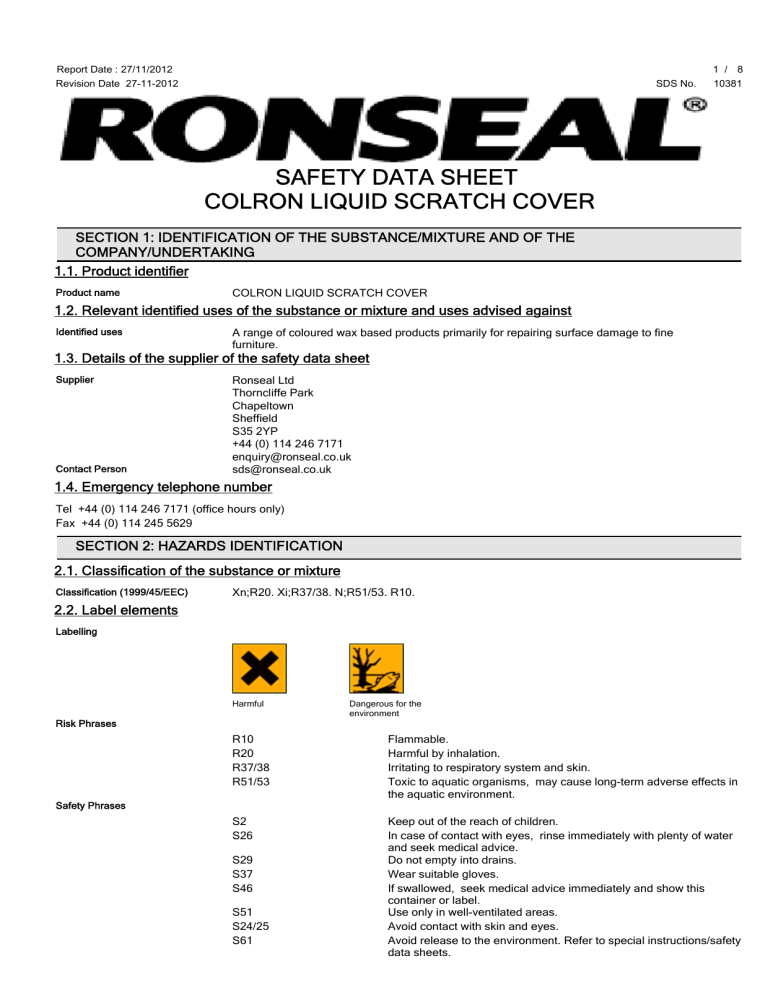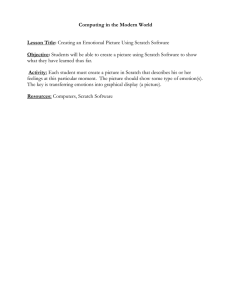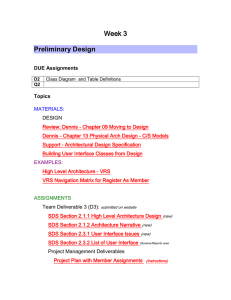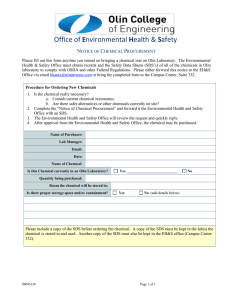safety data sheet colron liquid scratch cover

Report Date : 27/11/2012
Revision Date 27-11-2012
1 / 8
SDS No. 10381
SAFETY DATA SHEET
COLRON LIQUID SCRATCH COVER
SECTION 1: IDENTIFICATION OF THE SUBSTANCE/MIXTURE AND OF THE
COMPANY/UNDERTAKING
1.1. Product identifier
Product name COLRON LIQUID SCRATCH COVER
1.2. Relevant identified uses of the substance or mixture and uses advised against
Identified uses A range of coloured wax based products primarily for repairing surface damage to fine furniture.
1.3. Details of the supplier of the safety data sheet
Supplier
Contact Person
Ronseal Ltd
Thorncliffe Park
Chapeltown
Sheffield
S35 2YP
+44 (0) 114 246 7171 enquiry@ronseal.co.uk
sds@ronseal.co.uk
1.4. Emergency telephone number
Tel +44 (0) 114 246 7171 (office hours only)
Fax +44 (0) 114 245 5629
SECTION 2: HAZARDS IDENTIFICATION
2.1. Classification of the substance or mixture
Classification (1999/45/EEC)
2.2. Label elements
Xn;R20. Xi;R37/38. N;R51/53. R10.
Labelling
Risk Phrases
Safety Phrases
Harmful
R10
R20
R37/38
R51/53
S2
S26
S29
S37
S46
S51
S24/25
S61
Dangerous for the environment
Flammable.
Harmful by inhalation.
Irritating to respiratory system and skin.
Toxic to aquatic organisms, may cause long-term adverse effects in the aquatic environment.
Keep out of the reach of children.
In case of contact with eyes, rinse immediately with plenty of water and seek medical advice.
Do not empty into drains.
Wear suitable gloves.
If swallowed, seek medical advice immediately and show this container or label.
Use only in well-ventilated areas.
Avoid contact with skin and eyes.
Avoid release to the environment. Refer to special instructions/safety data sheets.
Report Date : 27/11/2012
COLRON LIQUID SCRATCH COVER
2.3. Other hazards
SECTION 3: COMPOSITION/INFORMATION ON INGREDIENTS
3.2. Mixtures
1,2,4-TRIMETHYLBENZENE
CAS-No.: 95-63-6 EC No.: 202-436-9
Classification (67/548/EEC)
R10
Xn;R20
Xi;R36/37/38
N;R51/53
Classification (EC 1272/2008)
Flam. Liq. 3 - H226
Acute Tox. 4 - H332
Skin Irrit. 2 - H315
Eye Irrit. 2 - H319
STOT SE 3 - H335
Aquatic Chronic 2 - H411
CUMENE
CAS-No.: 98-82-8
Classification (EC 1272/2008)
Flam. Liq. 3 - H226
STOT SE 3 - H335
Asp. Tox. 1 - H304
Aquatic Chronic 2 - H411
MESITYLENE
CAS-No.: 108-67-8
EC No.: 202-704-5
EC No.: 203-604-4
Classification (67/548/EEC)
R10
Xn;R65
Xi;R37
N;R51/53
Classification (EC 1272/2008)
Flam. Liq. 3 - H226
STOT SE 3 - H335
Aquatic Chronic 2 - H411
Solvent naphtha (petroleum), light arom.
CAS-No.: 64742-95-6 EC No.: 265-199-0
Classification (EC 1272/2008)
Not classified.
XYLENE
CAS-No.: 1330-20-7 EC No.: 215-535-7
Classification (67/548/EEC)
R10
Xi;R37
N;R51/53
Classification (67/548/EEC)
Xn;R65.
N;R51/53.
Classification (EC 1272/2008)
Flam. Liq. 3 - H226
Acute Tox. 4 - H312
Acute Tox. 4 - H332
Skin Irrit. 2 - H315
Classification (67/548/EEC)
R10
Xn;R20/21
Xi;R38
The Full Text for all R-Phrases and Hazard Statements are Displayed in Section 16.
2 / 8
SDS No. 10381
10-25%
< 1%
2.5-10%
25-50%
2.5-10%
Report Date : 27/11/2012 3 / 8
SDS No. 10381
COLRON LIQUID SCRATCH COVER
SECTION 4: FIRST AID MEASURES
4.1. Description of first aid measures
General information
In all cases of doubt, or when symptoms persist, seek medical attention. Never give anything by mouth to an unconscious person. If unconscious place in recovery position and seek medical advice.
Inhalation
Remove to fresh air, keep the patient warm and at rest. If breathing has stopped administer artificial respiration. Give nothing by mouth.
Ingestion
If accidentally swallowed rinse the mouth with plenty of water (only if person is conscious) and obtain immediate medical attention. Keep at rest. Do NOT induce vomiting.
Skin contact
Remove contaminated clothing. Wash skin thoroughly with soap and water, or use a recognised skin cleanser. Do NOT use solvents or thinners. Seek medical advice if any irritation persists.
Eye contact
Contact lenses should be removed. Remove contact lenses, irrigate copiously with clean, fresh water, holding the eyelids apart for at least 10 minutes and seek immediate medical advice.
4.2. Most important symptoms and effects, both acute and delayed
4.3. Indication of any immediate medical attention and special treatment needed
SECTION 5: FIREFIGHTING MEASURES
5.1. Extinguishing media
Extinguishing media
Fire can be extinguished using: recommended: alcohol resistant foam, carbon dioxide (CO2), powders, water spray/ mist.
Not to be used for safety reasons: water jet.
5.2. Special hazards arising from the substance or mixture
5.3. Advice for firefighters
Special Fire Fighting Procedures
Fire will produce dense black smoke containing hazardous products of combustion (see Section 10). Exposure to decomposition products may be hazardous to health. Appropriate self-contained breathing apparatus may be required. Cool closed containers exposed to fire with water spray. Do not allow run-off from fire fighting to enter drains or watercourses.
SECTION 6: ACCIDENTAL RELEASE MEASURES
6.1. Personal precautions, protective equipment and emergency procedures
Exclude sources of ignition and ventilate the area. Avoid breathing vapours. Refer to protective measures listed in sections 7 and 8.
6.2. Environmental precautions
Do not allow to enter drains, sewers or watercourses. If the product contaminates lakes, rivers or sewage, inform appropriate authorities in accordance with local regulations.
6.3. Methods and material for containment and cleaning up
Exclude non-essential personnel. Contain and collect spillage with non-combustible absorbent materials, e.g. sand, earth or vermiculite, and place in a suitable container for disposal in accordance with the waste regulations (see Section 13).
Clean preferably with a detergent; avoid the use of solvents.
6.4. Reference to other sections
SECTION 7: HANDLING AND STORAGE
7.1. Precautions for safe handling
Report Date : 27/11/2012 4 /
SDS No. 10381
COLRON LIQUID SCRATCH COVER
Prevent the creation of flammable or explosive concentrations of vapour in air and avoid vapour concentrations higher than the occupational exposure limits. In addition, the product should only be used in areas from which all naked lights and other sources of ignition have been excluded. Electrical equipment should be protected to the appropriate standard. Mixture may charge electrostatically: always use earthing leads when transferring from one container to another. Operators should wear anti-static footwear and clothing and floors should be of the conducting type. Isolate from sources of heat, sparkes and open flame. Non-sparking tools should be used. Avoid skin and eye contact. Avoid the inhalation of dust, particulates and spray mist arising from application of this mixture. Avoid inhalation of dust from sanding. Smoking, eating and drinking should be prohibited in application area.
For personal protection, refer to Section 8. Never use pressure to empty: container is not a pressure vessel. Always keep in containers of same material as original one. Comply with health and safety at work laws. Do not allow to enter drains or water courses. Vapours are heavier than air and may spread along floors. Vapours may form explosive mixtures with air.
The Manual Handling Operations Regulations may apply to the handling of containers/packages of this product. Refer to the guide weight indicated on the container when carrying out assessments.
7.2. Conditions for safe storage, including any incompatibilities
8
Observe the label precautions. Store between 5°C and 25°C in a dry, well ventilated place away from sources of heat and direct sunlight. Keep in a cool, dry, well ventilated place, away from sources of heat, ignition and direct sunlight. No smoking. Store separately from oxidising agents and strongly alkaline and strongly acidic materials.
To avoid the risk of spillage, always store and transport in a secure and upright position. The principles contained in the
HSE guidance note Chemical Warehousing: The Storage of Packed Dangerous Substances, should be observed when storing this product. Store in accordance with the Dangerous Substances and Explosive Atmospheres Regulations
(DSEAR). The requirements are given in the HSE Approved Code of Practice and Guidance, Storage of Dangerous
Substances: DSEAR. Prevent unauthorised access.
7.3. Specific end use(s)
SECTION 8: EXPOSURE CONTROLS/PERSONAL PROTECTION
8.1. Control parameters
Name STD TWA - 8 Hrs
1,2,4-TRIMETHYLBENZENE WEL 25 ppm
CUMENE
MESITYLENE
WEL
WEL
25 ppm(Sk)
25 ppm
Solvent naphtha (petroleum), light arom.
SUP
XYLENE WEL 50 ppm(Sk)
WEL = Workplace Exposure Limit.
Ingredient Comments
According to EH40 - List of approved workplace exposure limits.
125 mg/m3
125 mg/m3(Sk)
125 mg/m3
200 mg/m3
220 mg/m3(Sk)
STEL - 15 Min
50 ppm(Sk)
100 ppm(Sk)
250 mg/m3(Sk)
441 mg/m3(Sk)
Notes
8.2. Exposure controls
Engineering measures
Provide adequate ventilation. Where reasonably practicable, this should be achieved by the use of local exhaust ventilation and good general extraction. If these are not sufficient to maintain concentrations of particulates and/or solvent vapours below the relevant occupational exposure limits, suitable respiratory protective equipment should be worn.
Respiratory equipment
If workers are exposed to concentrations above the exposure limit they must use appropriate, certified respirators.
Hand protection
There is no one glove material or combination of materials that will give unlimited resistance to any individual or combination of chemicals. For prolonged or repeated handling, use nitrile gloves. The breakthrough time must be greater than the end use time of the product. The instructions and information provided by the glove manufacturer on use, storage, maintenance and replacement must be followed. Gloves should be replaced regularly and if there is any sign of damage to the glove material. Always ensure that gloves are free from defects and that they are stored and used correctly. The performance or effectiveness of the glove may be reduced by physical/chemical damage and poor maintanance. Barrier creams may help to protect the exposed areas of the skin, they should however not be applied once exposure has occurred.
Eye protection
Eye protection designed to protect against liquid splashes should be worn.
Report Date : 27/11/2012 5 / 8
SDS No. 10381
COLRON LIQUID SCRATCH COVER
Other Protection
Cotton or cotton/synthetic overalls or coveralls are normally suitable. Grossly contaminated clothing should be removed and the skin washed with soap and water or a proprietary skin cleaner.
All personal protective equipment, including respiratory protective equipment, used to control exposure to hazardous substances must be selected to meet the requirements of the COSHH Regulations.
Environmental Exposure Controls
Do not allow to enter drains or water courses.
SECTION 9: PHYSICAL AND CHEMICAL PROPERTIES
9.1. Information on basic physical and chemical properties
Appearance
Colour
Odour
Solubility
Initial boiling point and boiling range
Melting point (°C)
Vapour pressure
Flash point
Auto Ignition Temperature (°C)
Flammability Limit - Lower(%)
Flammability Limit - Upper(%)
9.2. Other information
Structured liquid.
Colour will vary dependent on individual shade.
Characteristic solvent type.
Immiscible with water.
160-200 760 mm Hg
<-30
0.33 kPa 20
44 CC (Closed cup).
350
0.8
7.0
SECTION 10: STABILITY AND REACTIVITY
10.1. Reactivity
10.2. Chemical stability
Stable if stored under recommended storage and handling conditions (see section 7).
10.3. Possibility of hazardous reactions
Keep away from oxidising agents, strongly alkaline and strongly acidic materials to avoid exothermic reactions.
10.4. Conditions to avoid
When exposed to high temperatures may produce hazardous decomposition products.
10.5. Incompatible materials
10.6. Hazardous decomposition products such as smoke, carbon monoxide, carbon dioxide, oxides of nitrogen etc..
SECTION 11: TOXICOLOGICAL INFORMATION
11.1. Information on toxicological effects
Toxicological information
There is no data available on the mixture itself.
The mixture has been assessed following the conventional method of the Dangerous Preparations Directive 1999/45/EC and classified for toxicological hazards accordingly.
See sections 2 and 15 for details.
Exposure to organic solvent vapours in excess of the stated occupational exposure limit may result in adverse health effects such as irritation of the mucous membrane and the respiratory system and adverse effects on the kidney, liver and central nervous systems. Symptoms and signs include headache, dizziness, fatigue, muscular weakness, drowsiness and in extreme cases loss of consciousness.
Solvents may cause some of the above effects by absorption through the skin.
Repeated or prolonged contact with the product may lead to removal of natural fats from the skin resulting in non-allergic contact dermatitis and absorption through the skin. Splashes in the eyes may cause irritation and reversible local damage.
Report Date : 27/11/2012
COLRON LIQUID SCRATCH COVER
Ingestion may cause nausea, vomiting and diarrhoea.
This takes into account, where known, delayed and immediate effects and also chronic effects of components from short-term and long-term exposure by oral, inhalation and dermal routes of exposure and eye contact.
6 / 8
SDS No. 10381
SECTION 12: ECOLOGICAL INFORMATION
Ecotoxicity
There is no data on the product itself. Do not allow to enter drains or water courses. The mixture has been assessed following the conventional method of the Dangerous Preparations Directive 1999/45/EC and is classified for eco-toxicological properties accordingly. See sections 2 and 3 for details
12.1. Toxicity
12.2. Persistence and degradability
12.3. Bioaccumulative potential
12.4. Mobility in soil
12.5. Results of PBT and vPvB assessment
12.6. Other adverse effects
SECTION 13: DISPOSAL CONSIDERATIONS
13.1. Waste treatment methods
Do not allow into drains or watercourses, or dispose of where ground or surface waters may be affected. Wastes and emptied containers are controlled wastes and should be disposed of in accordance with The Environmental Protection (Duty of Care) Regulations (in England, Scotland & Wales) or The Controlled Waste (Duty of Care) Regulations in Northern
Ireland. The European Waste Catalogue classification of this product, when disposed of as waste, is 08 01 11* (waste paint and varnish containing organic solvents or other dangerous substances). If this product is mixed with other wastes, the original waste product code may no longer apply and the appropriate code should be assigned. For further information contact your local waste authority. Using information in this safety data sheet, advice should be obtained from the relevant waste authority on the classification of empty containers.
SECTION 14: TRANSPORT INFORMATION
General
Transport within user's premises: always transport in closed containers that are upright and secure. Ensure that persons transporting the product know what to do in an accident or spillage.
Limited Quantity concessions may apply to the carriage of this product.
Marine Pollutant [Petroleum Distillates] Sea Transport Notes
14.1. UN number
UN No. (ADR/RID/ADN) 1263
UN No. (IMDG) 1263
14.2. UN proper shipping name
Proper Shipping Name Paint
14.3. Transport hazard class(es)
ADR/RID/ADN Class
IMDG Class
Transport Labels
Class 3: Flammable liquids.
3
Report Date : 27/11/2012
COLRON LIQUID SCRATCH COVER
FLAMMABLE
LIQUID
3
14.4. Packing group
ADR/RID/ADN Packing group III
IMDG Packing group
14.5. Environmental hazards
III
Environmentally Hazardous Substance/Marine Pollutant
7 / 8
SDS No. 10381
14.6. Special precautions for user
EMS
Tunnel Restriction Code
F-E; S-E
(D/E)
14.7. Transport in bulk according to Annex II of MARPOL73/78 and the IBC Code
SECTION 15: REGULATORY INFORMATION
15.1. Safety, health and environmental regulations/legislation specific for the substance or mixture
Uk Regulatory References
The information contained in this safety data sheet does not constitute the user's own assessment of workplace risks as required by other health and safety legislation.
The provisions of the Health and Safety at Work etc. Act and the Control of Substances Hazardous to Health Regulations apply to the use of this product at work.
The Manual Handling Operations Regulations
The Chemicals (Hazard Information and Packaging for Supply) Regulations.
The Carriage of Dangerous Goods and Use of Transportable Pressure Equipment Regulations.
European Agreement concerning the International Carriage of Dangerous Goods by Road [ADR]
Guidance Notes
Workplace Exposure Limits EH40.
EU Legislation
Dangerous Preparations Directive 88/379. Dangerous Substance Directive 67/548 Safety Data Sheet Directive 91/155
Water hazard classification
The product should not be allowed to enter drains or watercourses, or be deposited where it can affect ground or surface waters. There is no data available on the product itself.
15.2. Chemical Safety Assessment
SECTION 16: OTHER INFORMATION
General information
The information contained in this safety data sheet is based on the present state of knowledge and current national legislation. It provides guidance on health, safety and environmental aspects of the product and should not be construed as any guarantee of technical performance or suitability for particular applications.
Report Date : 27/11/2012 8 /
SDS No. 10381
COLRON LIQUID SCRATCH COVER
The product should not be used for purposes other than those shown in section 1 without first referring to the supplier and obtaining written handling instructions. As the specific conditions of use of the product are outside the supplier's control, the user is responsible for ensuring that the requirements of relevant legislation are complied with.
8
Regulation 8 (12) of CHIP allows dangerous preparations in pack sizes of not more than 125ml not to show risk and/or safety phrases if classified in certain categories of danger. This derogation is being applied to the labelling of this preparation.
For specific guidance contact Ronseal Technical Services. [Helpline +44 (0) 114 240 9469 ] ; Email: enquiry@ronseal.co.uk
Revision Comments
New format.
Revision Date
SDS No.
Safety Data Sheet Status
Risk Phrases In Full
27-11-2012
10381/2
Approved.
R10
R20/21
R20
R65
R36/37/38
R37/38
R37
R38
Flammable.
Harmful by inhalation and in contact with skin.
Harmful by inhalation.
Harmful: may cause lung damage if swallowed.
Irritating to eyes, respiratory system and skin.
Irritating to respiratory system and skin.
Irritating to respiratory system.
Irritating to skin.
Toxic to aquatic organisms, may cause long-term adverse effects in the aquatic environment.
R51/53
Hazard Statements In Full
H226
H304
H312
H315
H319
Flammable liquid and vapour.
May be fatal if swallowed and enters airways.
Harmful in contact with skin.
Causes skin irritation.
Causes serious eye irritation.
H332
H335
H411
Harmful if inhaled.
May cause respiratory irritation.
Toxic to aquatic life with long lasting effects.
Disclaimer
Information contained in this Safety Data Sheet is based on data considered to be accurate at the time of its preparation. Despite our efforts, it may not be up to date or applicable to the circumstances of any particular case. ,
The supplier accepts no responsibility whatsoever (except otherwise provided in law) for any damage or injury resulting from abnormal use, from any failure to follow appropriate practices or from hazards inherent in the product.




